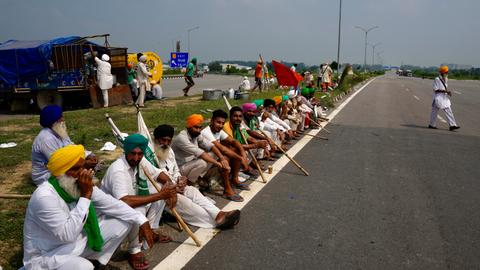
Here’s a look into the country’s most prolonged farmer protests in history, as unions intensified their year-long protests at the borders of New Delhi ahead of a crucial court hearing on October 21.
Hearing a petition on whether India’s farmers have the right to protest, India’s Supreme Court said that farmers can protest but cannot block roads indefinitely.
The judgement came on Thursday, giving farmer unions three weeks to remove their protest tents outside at the New Delhi border.
How did India, a country which takes pride in its farmers, reach a point where farmers have been encamping outside the capital city for over a year?
It all began almost immediately after the Indian parliament led by Prime Minister Narendra Modi’s majoritarian government cleared the farm laws last fall. Tens of thousands of farmers from Punjab, an agricultural state known as the breadbasket of India, and its neighbouring state Haryana march down to the capital city New Delhi.
The police blocked the procession at the border of New Delhi, but the farmers were determined to revoke the farm laws. The situation came to the point when the Modi government entered a year-long deadlock with farmers. Their movement became India’s longest-running farmers’ protest against the government.
Although the Modi government initially either downplayed or dismissed the farmers’ agitation, it eventually came to the table with them, holding several rounds of talks with farm union leaders.
The deadlock, however, ensued.
While engaging in talks with the farmers union and ensuring that the police barricade remained intact to keep the protesting agricultural population in the north outside the capital city’s borders, the Modi government failed to convince the farming communities from the rest of the country with the new farm laws.
Farmers from other parts of the country joined the protest and simultaneously led a series of demonstrations in different states.
For several decades, Indian farmers have relied on 7000 government-regulated wholesale markets to sell their yearly agricultural yield.
These markets are largely run by committees comprising farmers with large landholdings, local traders or agents who arbitrate between a farmer and a wholesaler. The committees also look after the logistical needs, such as organising transportation and storage facilities.
The new farm laws have certain provisions that farmer unions fear will render these committees irrelevant, allowing farmers to rely less on these wholesale markets and shepherd them toward big businesses who have strong financial capitals to monopolise the entire agricultural sector.
“We will lose our lands, we will lose our income if you let big businesses decide prices and buy crops. We don’t trust big business. Free markets work in countries with less corruption and more regulation. It can’t work for us here,” Gurnam Singh Charuni, one of the main leaders of the agitation, said to BBC at the peak of the agitation last year.
A year on, farmer unions are calling for the complete withdrawal of the laws and asking for a new law that would make the government legally bound to purchase every farm produce at a state-regulated price.
The new demand has become widely popular among India’s farming community. Now the farmer protests are not just confined to the Punjab and Haryana states. It’s become a pan-India agitation.
Farmer unions play hardball
Aware of the ruling Bharatiya Janata Party’s strong appetite for winning elections in every state and maintaining a strong presence in both the central parliament and state assemblies, union leaders have taken their fight to the north Indian state of Uttar Pradesh, which is going to hold elections in May 2022.
Home to 240 million people, Uttar Pradesh is India’s most populated state, which the Bharatiya Janata Party has led since 2017.
Farm union leaders plan to portray the BJP as an anti-farmer party, knowing that this rhetoric would cost them electorally, especially in western Uttar Pradesh, where agriculture is a mainstay.
Farmer leaders plan to visit every city and town in Uttar Pradesh to inform people how dangerous Modi’s government is for the farming community.
The electoral victory in Uttar Pradesh, which sends the highest number of lawmakers to parliament, is often seen as a significant indicator of which party will come to power in the national elections.
Therefore, farmer unions are now sharpening their focus on the state to upset the ruling party as much as possible.
Source: TRT World
Why are Indian farmers protesting for over a year?
Source: News Achor Trending

0 Comments